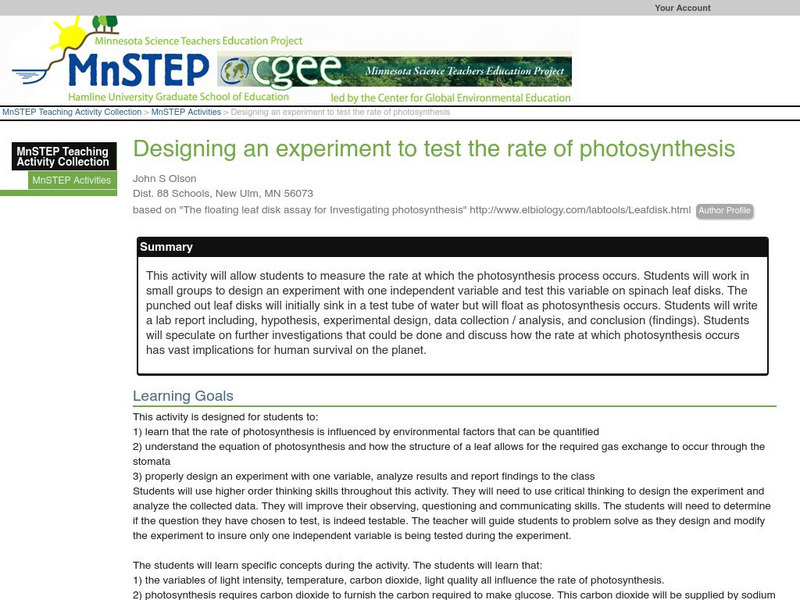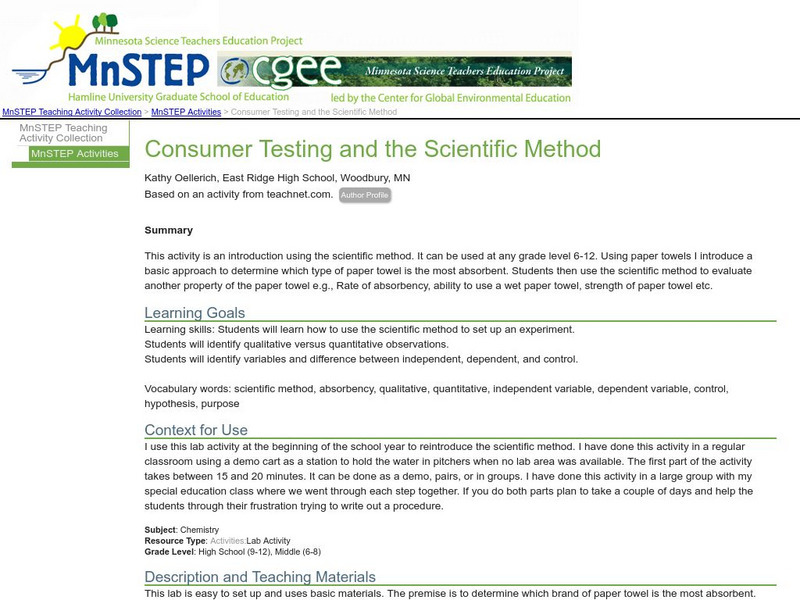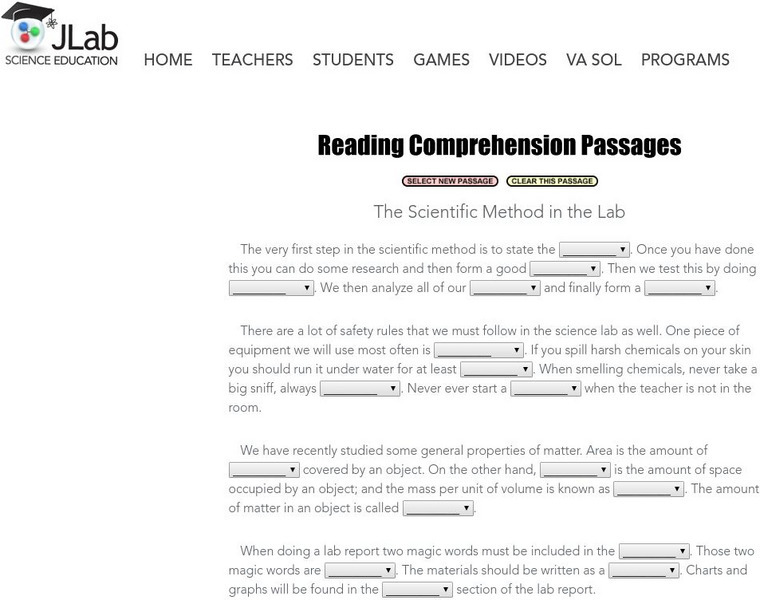Science Education Resource Center at Carleton College
Serc: Investigating Earth and Moon Surface: Impact Craters
In this activity, students will investigate how impact craters are formed. In small groups, students will build a model of the moon's surface with flour paste and drop a marble from different heights to discover how the speed of an...
Science Education Resource Center at Carleton College
Serc: Designing an Experiment to Test the Rate of Photosynthesis
Using spinach leaf disks, students measure the rate at which the photosynthesis process occurs. Students speculate on further investigations that could be done and discuss how the rate at which photosynthesis occurs has vast implications...
Science Education Resource Center at Carleton College
Serc: Candle Drop
By using this discrepant event, students will be guided through an investigation using a burning candle in a jar. The teacher will hold a burning candle in a jar over his/her head. When dropped, the candle will extinguish when caught....
Science Education Resource Center at Carleton College
Serc: Consumer Testing and the Scientific Method
Using paper towels, introduce a basic approach to determine which type of paper towel is the most absorbent using the scientific method. Students learn to evaluate properties of paper towels: rate of absorbency, ability to use a wet...
Science Education Resource Center at Carleton College
Serc: Mn Step: Scientific Method Lab Using Bubble Gum
For this activity, students apply the scientific method while doing an experiment that involves the variables of bubble gum. They will investigate the size of bubbles that can be blown with two different types of bubble gum, and the...
Science Education Resource Center at Carleton College
Serc: Mn Step: Scientific Methods: Using "Awakenings" to Dispel Misconceptions
An activity where young scholars watch the movie "Awakenings" starring Robin Williams. The purpose of the lesson is for students to record on a tally sheet each time they notice a step in the scientific method being used. They will...
Science Education Resource Center at Carleton College
Serc: Bubbling Blobs
In this chemistry lab, young scholars investigate how oil and water don't mix. They will work on their observation skills and their ability to follow directions to ensure they get the correct results. Students can then develop a new,...
Science Education Resource Center at Carleton College
Serc: Determining the Geologic History of Rocks From a Gravel Deposit
Gravels deposited as a result of continental glaciation are used to teach the application of the scientific method in a cooperative learning mode which utilizes hands-on, minds-on analyses.
Polk Brothers Foundation Center for Urban Education at DePaul University
De Paul University: Center for Urban Education: Mousie [Pdf]
"Mousie" is a one page, fictional, reading passage about a boy who caught, tamed, and learned about mice using a scientific method. It is followed by constructed-response questions which require students to provide evidence from the...
Math Science Nucleus
I. Science Ma Te: Integrating Science, Math and Technology
This site offers a wealth of online textbook-related materials that encourage the discovery of science in the world around us. Enter the site to access material on specific topics. Each section contains reading material (complete with...
TED Talks
Ted: Ted Ed: Can You Solve This?
In this video, Veritasium asks people to try and figure out the rules of a pattern presented. This video teaches us about the scientific method and how our preconceived notions can affect how we discover new information. [4:43]
Thomas Jefferson National Accelerator Facility
Jefferson Lab: Reading Passages: The New Scientific Method in the Lab
Read and fill in the blanks of this passage explaining the new scientific method procedure in the lab. Each blank has a dropdown menu with choices. When you finish, click CHECK MY ANSWERS. If you pick a wrong answer, the right answer...
University of California
University of California Museum of Paleontology: Science Checklist [Pdf]
Use this seven item checklist to make sure all the parts of a good science investigation are in place.
Science Buddies
Science Buddies: Steps of the Scientific Method
An explanation of the scientific method for learners preparing a science fair project, or any science project. Each step of the process is supported with additional helpful information and advice.
Science Buddies
Science Buddies: Scientific Method Variables/hypothesis
Find out what variables are in a scientific investigation and what the difference is between an independent, dependent, and controlled variable. Look at samples of different types of variables and find out what makes a good variable.
Science Buddies
Science Buddies: Scientific Method Conclusion
The conclusion of a science experiment summarizes how your results supported or contradicted your hypothesis. See a sample of a conclusion and find out what makes a good conclusion.
Other
Horror Vacui: Robert Boyle
A brief biography of Boyle, focused on his scientific achievements.
Other
Science Fair Primer
An experienced science teacher shares detailed information regarding how students develop science fair projects. In addition to the key steps involved in working through a project, you will find judging guidelines and links to other...
Everything ESL
Everything Esl: Science Experiments With Eggs
Find lesson plans for four different experiments to introduce the Scientific Method to ESL students. Find out the benefits of using science experiments in the ESL classes.
McGraw Hill
Glencoe Biology: Methods of Science: Self Check Quiz
Take this self-checking, five question practice quiz over various methods of science.
Frontiers Media
Frontiers: The Amazing History of Neuroscience
An easy to understand article on the history of brain study.
National Health Museum
Access Excellence: Step by Step Science Fair Success
This site from Access Excellence provides a wealth of information regarding how to run a science fair for middle school students. Content explores the planning process, guidelines, student tasks and paperwork, examples, assessment, and...
National Health Museum
Access Excellence: The Blackout Syndrome
Become a medical investigator trying to solve the cause of a mysterious disease. Through a four-part mystery series, students try to figure out the source of the disease and how to treat it. By reading clues students make predictions and...
National Health Museum
Access Excellence: In Search of Real Science
The author of this paper discusses some of the challenges and problems encountered when teaching science and the scientific method to students. He provides links for some sample lessons. Site by Access Excellence.










![De Paul University: Center for Urban Education: Mousie [Pdf] Unit Plan De Paul University: Center for Urban Education: Mousie [Pdf] Unit Plan](https://d15y2dacu3jp90.cloudfront.net/images/attachment_defaults/resource/large/FPO-knovation.png)











